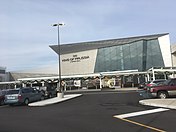King of Prussia, Pennsylvania | |
|---|---|
| Nickname: KOP | |
Location of King of Prussia in Pennsylvania | |
| Coordinates: 40°05′21″N 75°23′46″W / 40.08917°N 75.39611°W | |
| Country | United States |
| State | Pennsylvania |
| County | Montgomery |
| Township | Upper Merion |
| Founded | 1719 |
| Named for | King of Prussia Inn |
| Area | |
| • Total | 8.66 sq mi (22.44 km2) |
| • Land | 8.49 sq mi (22.00 km2) |
| • Water | 0.17 sq mi (0.44 km2) |
| Elevation | 200 ft (60 m) |
| Population | |
| • Total | 24,695 |
| • Density | 2,907.00/sq mi (1,122.43/km2) |
| Time zone | UTC-5 (Eastern (EST)) |
| • Summer (DST) | UTC-4 (EDT) |
| ZIP Code | 19406 |
| Area codes | 610 and 484 |
| GNIS feature ID | 1178473[3] |
King of Prussia (also KOP)[4] is a census-designated place in Upper Merion Township in Montgomery County, Pennsylvania, United States. The community took its unusual name in the 18th century from a local tavern named the King of Prussia Inn, which was named after King Frederick the Great of Prussia. King of Prussia is considered to be an edge city of Philadelphia, consisting of large amounts of retail and office space situated at the convergence of four highways.
King of Prussia is located 35 miles (56 km) south of Allentown and 15 miles (24 km) northwest of Philadelphia. It is considered part of the larger Philadelphia metropolitan area. As of the 2020 census, its population was 22,028.
King of Prussia mall is the third-largest shopping mall in the US. The headquarters of the Nuclear Regulatory Commission Region I and American Baptist Churches USA are located in King of Prussia.
- ^ "ArcGIS REST Services Directory". United States Census Bureau. Retrieved October 12, 2022.
- ^ Cite error: The named reference
USCensusDecennial2020CenPopScriptOnlywas invoked but never defined (see the help page). - ^ "King of Prussia". Geographic Names Information System. United States Geological Survey, United States Department of the Interior.
- ^ Huber, Robert (March 2017). "The Promised Land?". Philadelphia Magazine. pp. 76–79, 128–134.






